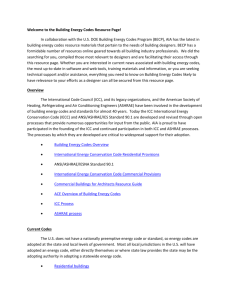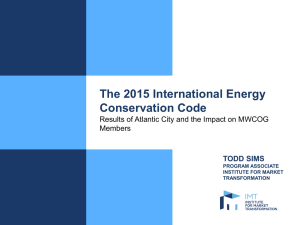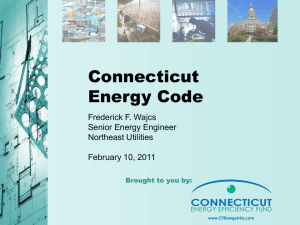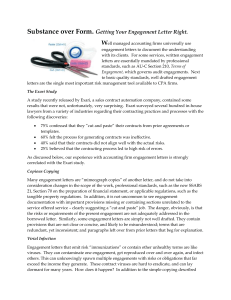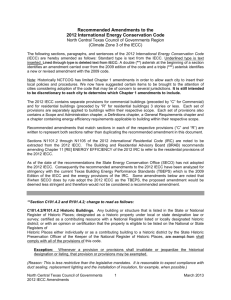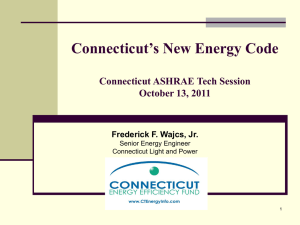Response to Request for Proposals (RFP)
advertisement
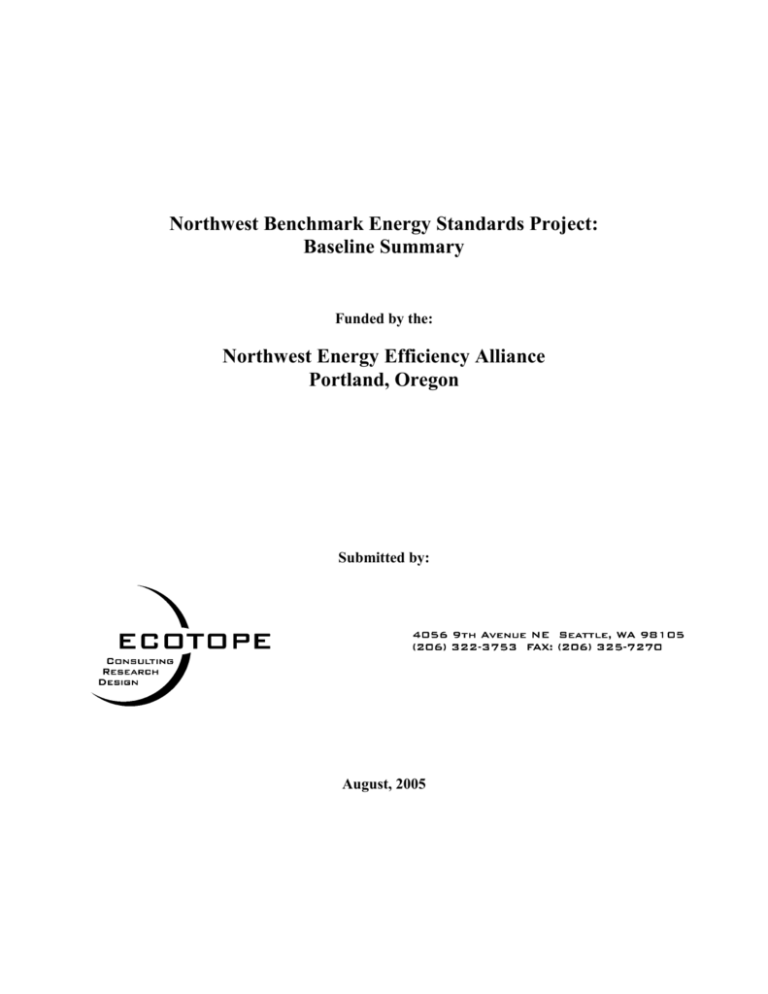
Northwest Benchmark Energy Standards Project: Baseline Summary Funded by the: Northwest Energy Efficiency Alliance Portland, Oregon Submitted by: August, 2005 Table of Contents 1. 2. Introduction .................................................................................................................. i Non-Residential .......................................................................................................... 1 2.1. Non-Residential Lighting.................................................................................... 2 2.2. Non-Residential Opaque Envelope Provisions ................................................... 6 2.3. Non-Residential Glazing Provisions ................................................................... 7 2.4. Non-Residential Mechanical System Equipment Provisions ............................. 7 3. Residential................................................................................................................. 11 3.1. Envelope Provisions.......................................................................................... 11 3.2. Ducts and Equipment ........................................................................................ 12 3.3. Other Provisions................................................................................................ 12 3.4. Incompatibilities with the IECC ....................................................................... 12 3.5. Performance Standards ..................................................................................... 15 APPENDIX A: Technical Advisory Group Member Roster ......................................... A-1 APPENDIX B: Non-Residential Prescriptive Lighting Examples ................................ B-1 Table of Tables Table 2.1-1. Table 2.1-2. Table 2.1-3. Table 2.2-1. Table 2.3-1. Table 2.4-1. Table 3.4-1. Table 3.4-2. Non-Residential Interior Lighting Requirements .......................................... 2 Non-Residential Exterior Lighting Requirements ......................................... 4 Non-Residential Interior Lighting Power Density ........................................ 4 Non-Residential Opaque Envelope Requirements ........................................ 6 Non-Residential Glazing Requirements ........................................................ 7 Non-Residential Mechanical System Requirements ..................................... 8 Residential Envelope Requirements ............................................................ 13 Other Residential Provisions ....................................................................... 14 Best of Region Baseline Provisions i 1. Introduction In the summer of 2005, the Northwest Energy Efficiency Alliance (“Alliance”) contracted with Ecotope to develop the Northwest Benchmark Energy Standards (NWBEST). The goal of NWBEST is to establish guidelines that will reduce new building energy use in the Northwest by 15 percent. NWBEST is intended serve as a guideline for jurisdiction and state code adoptions and for regional conservation programs over the next five to seven years. NWBEST is not itself a code (though it provides adoptable code language); it is intended to help jurisdictions establish code adoption goals significantly beyond existing codes while remaining politically and technically practical. Such language could also give guidance to utility sponsored efficiency programs by providing a specific language that could form the basis of such programs. It covers both residential and non-residential buildings. This project was divided into two primary goals: • Phase I: Develop a “Best of Region” baseline to serve as the evaluation baseline for the NWBEST provisions. This baseline will capture the most stringent regional energy code requirements for each building component. • Phase II: Develop NWBEST provisions that exceed the “Best of Region” baseline to achieve 15% more efficiency. This interim report contains the provisions of the “Best of Region” baseline as developed by Ecotope and approved by the Technical Advisory Group (TAG) on June 16, 2005. The TAG consists of energy code experts from around the region and was created by the Alliance to ensure a consensus regarding regional energy guideline development. TAG members provided extensive comments on the draft baseline and, insofar as possible, their comments and input have been included in this document. Appendix A lists the members of the TAG. To develop the “Best of Region” baseline, Ecotope reviewed the most widely-enforced regional energy codes, including the Washington and Oregon State Energy Codes (WSEC and OSEC), the Seattle Energy Code (SEC), and the International Energy & Conservation Code (IECC), both 2003 and 2004, to develop a composite standard that includes the best regional standard for each component. As such, it is more stringent than any existing state energy code. 2. Non-Residential Our review of the non-residential provisions of the region’s enforced codes indicates that there is general consensus in many aspects of the code regulations. The most significant differences often reside in the exceptions and exemptions. While the City of Seattle and State of Oregon energy codes regulate aspects of buildings not regulated in the other Best of Region Baseline Provisions 1 codes, each regional code has areas where it is most stringent. Although the ASHRAE standard was not specifically included in this comparison, it has informed the development of much of the nation’s energy code development, and includes particularly well-written language in some areas. Where appropriate (especially in terms of equipment type), the basic ASHRAE structure has been used for this analysis. 2.1. Non-Residential Lighting The following provisions constitute the Best of Region lighting baseline: 2.1.1. Standard Lighting Provisions Total connected interior lighting power. The total connected interior lighting power (Watts) shall be the sum of the watts of all interior lighting equipment as defined below. Screw lamp holders. The wattage shall be the maximum labelled wattage of the luminaire. Other luminaires. The wattage of all other lighting equipment shall be the wattage of the lighting equipment verified through data furnished by the manufacturer or other approved sources. Low-voltage lighting. The wattage shall be the specified wattage of the transformer supplying the system. Line-voltage lighting track and plug-in busway. The wattage shall be the greater of the wattage of the planned/installed luminaires or 50 W/linear foot. Exceptions to Non-Residential Lighting provisions: The connected power associated with the following lighting equipment is not included in calculating total connected lighting power. Specialized medical, dental and research lighting. Professional sports arena playing field lighting. Display lighting for exhibits in galleries, museums and monuments. Guestroom lighting in hotels, motels, boarding houses or similar buildings. Emergency lighting automatically off during normal building operation. Lighting for theatrical/television productions, and stage lighting in entertainment facilities. Non-permanent task lighting. Lighting installed within display cases that moves with cases. All exempt lighting shall be separately controlled from general area lighting. Table 2.1-1. Non-Residential Interior Lighting Requirements Best of Region Baseline Provisions 2 Item Lighting Controls Local Switching Maximum control zone size Occupancy Sensor Sweep/automated (occ) Max Sweep Zone size Max Sweep Override Zone size Max Override Time Daylight Zone Circuit Holiday Scheduling Continous Dimming Stepped Dimming Bi-level switching Guestroom lighting LPD Exemptions/Adjustments1 Retail - Display Case Retail - Display Window Retail - Building Showcase Retail - Display Luminaires Source Code Base Level any WA required in space. enclosed spaces plus 80% of 20 amps or 5% of total floor area if>100000sf OR required in ALL classrooms, meeting and conference rooms, and all offices <300sf SEA/OR required in all buildings >5000sf and all office occupancies>2000sf WA 20 amps or 5% of total floor area WA 5000sf or 5% of total floor are which ever is greater Any 2 WA required near perimeter and overhead glazing. IECC2003 requires "automatic holiday scheduling feature that turns off all loads for at least 24 hours" OR required in classrooms if there is overhead glazing or if vertical glazing is >50% of the wall -------Not Required IECC2003 required unless occupant sensor. IECC2003 Each room must have master switch exempt if lighting moves with display Not Exempt not exempt up to 1.5 w/ft2 allowed above maximum LPD for ceiling mounted, bi-directionally adjustable fixtures (unless 2-point track attachment), with LED, tungsten halogen, fluorescent, or HID lamps installed. Display/Museum Accent/Gallery Any Exempt Other Non-Retail Display OR Not exempt or could use SEC variation which exempts first floor building entrance lobby only. Decorative Fixtures SEC/WA/ not exempt OR Task Lighting LPD Any Exempt VDT Lighting Allowance SEC/WA/ 0.00 w/sf OR Production Lighting Any Exempt (Media,Theater) Best of Region Baseline Provisions OR or SEC OR OR or SEC SEC 3 Item Food Prep Miscellaneous Lighting Line Voltage Track Lighting Low Voltage Track Lighting Dual Lighting Systems Tandem Wiring (minimum 2 lamps/ballast) Airtight Can Lights Ceiling Height Commissioning Electric Motor Efficiency Electrical Transformers Wire Sizing Source Code any but WA Base Level not exempt SEC 50 watt/lineal foot SEC or OR 37.5w/lf or circuit capacity if lockout control then highest watt system only IECC 2003 yes if not EB and if available pair is within 10' for recessed or 1' if surface or pendant. IECC 2003 Required WA or OR None WA or Controls will be tested and calibrated. None Any >1 ph & not part of equipment SEC/OR none NEMA TP-1 1996 Table 2.1-2. Non-Residential Exterior Lighting Requirements Building or Space Use Open Parking Outdoor Area Façade Area Perimeter Covered Parking Non-Sales Canopy Sales Canopy (service station) Exterior Lighting Controls Source Code SEC SEC SEC SEC SEC SEC SEC any Base Level 0.15 W/ft2 0.15 W/ft2 0.15 W/ft2 (use illuminated area only) 7.50 W/ft2 (use illuminated perimeter only) 0.20 W/ft2 (or 0.30 W/ft2 if paint reflective) No special allotment 1.00 W/ft2 Automatic time switching or photocell. Table 2.1-3. Non-Residential Interior Lighting Power Density Building Or Area Type Auditorium Automotive facility Bank/financial institution (retail area) Classroom/lecture hall Convention, conference or meeting Center Corridor, restroom, support area Best of Region Baseline Provisions (W/ft2) Not Applicable 0.9 (OR) Not Applicable Not Applicable 1.2 (IECC) Tenant Area Or Portion Of Building (W/ft2) 1 (WA) Not Applicable 1.5 (ALL Codes) 1.4 (OR) 1.3 (IECC) Not Applicable 0.6 (OR) Entire Building 4 Building Or Area Type Courthouse/town hall Dining Dormitory (common area) Exercise center Exhibition hall Grocery store Gymnasium playing surface Hotel function (common area) Industrial work, < 20’ ceiling height Industrial work, > 20’ foot ceiling height Process Plants Kitchen Library Lobby – hotel Lobby – other Mall, arcade or atrium Medical Hospital Medical and clinical areas Medical Offices Motel (common area) Multifamily (common area) Museum Office Office Enclosed (<150sf) Parking garage Penitentiary Police station Fire station Post office Religious worship Restaurant Retail sales, wholesale showroom School Storage, industrial and commercial Storage, Pallet Rack Theaters - motion picture Theaters - performance Transportation Other Best of Region Baseline Provisions (W/ft2) 1.2 (OR, IECC2004) Not Applicable 1.0(WA) 1.0 (OR) Not Applicable 1.5 (All Codes) Not Applicable 1.0 (WA) 1.2 (IECC) Tenant Area Or Portion Of Building (W/ft2) Not Applicable 0.9 (IECC) Not Applicable 0.9 (OR,IECC) 1.3 (OR, IECC) 1.6 (IECC) 1.4 (OR,IECC) 1.3 1.2 (IECC) 1.5 (WA) 1.5 (WA) 1.0 (WA) Not Applicable 1.3 (OR, IECC) Not Applicable Not Applicable Not Applicable 1.2(OR) Not Applicable 1.0 (WA) 1.0 (OR) 0.7(OR) 1.0 (WA) 1.0 (All Codes) Not Applicable 0.2, 0.3 if reflective paint (SEC) 1.0 (IECC) 1.0 (All codes) 0.8 (OR) 1.1 (OR) 1.0 (WA) 1 (SCL) 1.5 + up to 1.5 display 1.2 (WA,IECC) 0.5 (WA) 0.8 (OR,IECC) 1.0 (WA) 1.0 (WA) 1.0 (OR,IECC) 0.6 (IECC) Not Applicable 1.2 (IECC,OR) 1.7 (IECC) 1.1 (IECC) 1.3 (IECC) 0.6 (IECC) Not Applicable 1.2 (IECC) Not Applicable Not Applicable Not Applicable 1.0 (IECC) 1.1 1.1 Entire Building Not Applicable Not Applicable Not Applicable Not Applicable Not Applicable Not Applicable Not Applicable 1.5 + up to 1.5 display Not Applicable 0.5 (WA) 0.8 (OR,IECC) Not Applicable Not Applicable Not Applicable 0.6 (IECC) 5 2.2. Non-Residential Opaque Envelope Provisions For the envelope provisions, the Best of the Region baseline divides the Northwest into 2 zones using a 6000 heating degree day guideline. All spaces shall be considered conditioned spaces, and shall comply with the requirements in Table 2.2-1 unless they meet the following criteria for semi-heated spaces. The installed heating equipment output, in Climate Zone 1, shall be 3 Btu/(h ft2) or greater but not greater than 8 Btu/(h ft2) and in Climate Zone 2, shall be 5 Btu/(h ft2) or greater but not greater than 12 Btu/(h ft2). Heating shall be controlled by a thermostat mounted not lower than the heating unit and capable of preventing heating above 44°F space temperature. Semi-heated spaces shall be exempt from the exterior wall insulation requirements. Table 2.2-1. Non-Residential Opaque Envelope Requirements Component Roof/Ceiling Attic Nom Ins Attic U-value Roof Nom Ins Roof U-value Roof Deck R-value Roof Deck U-value Metal Roof Nom Ins Metal Roof U-value Walls Wall Nom Ins Wall U-value Metal Frame Wall Nom Ins Metal Frame Wall Uvalue BG Wall Nom Ins BG Wall U-value Metal Wall Nom Ins Metal Wall U-value Mass Criteria Source Code Zone One Zone Two WA R30 0.036 R21 0.046 R21 0.046 R30 with thermal block1 0.046 R38 0.031 R25 0.039 R25 0.039 R30 with thermal block1 0.039 WA WA SCL R19 0.062 R13+R3.8ci R24 0.044 R13+R3.8ci WA 0.084 0.084 SCL WA WA WA OR R12 0.061 R13+R13 R12 0.061 R13+R13 WA WA IECC/WA WA WA WA IECC2003 Mass Wall Nom Ins WA Mass Wall U-value WA Mass Wall Interior Nom R CMU integral R IECC individual walls individual walls > 45lbs/sf > 45lbs/sf 2 R5.7ci R7.6ci2 AG Wall values AG Wall values filled cores filled cores +R5 +R5continuous continuous or or R11 framed R11 framed CMU integral U Best of Region Baseline Provisions 6 Component Doors Door U-value Door (rollup ) U-value Floors Floor Nom Insulation Floor U-value Slab Nom Insulation Slab F value Mass Floor ext insulation Heated Slab Semi-Heated Criteria Treatment Source Code WA/OR WA/OR Zone One Zone Two Hinged <4' Hinged <4' wide wide U0.6 , all U0.6 , all other other U0.2 U0.2 Coil U0.6, Coil U0.6, panel panel U0.2 U 0.2 IECC R19 R25 WA R10 for 2' 0.54 R19 R10 for 3' R10 for 2' 0.54 R25 R10 for 3' 8btu/sf Exempts wall Ins only 12btu/sf Exempts wall Ins only WA WA WA SCL 1. Thermal blocks are a minimum R-5 of rigid insulation, which extends 1" beyond the width of the purlin on each side, perpendicular to the purlin. 3. R-5.7 ci may be substituted with concrete block walls complying with A5TM C90, ungrouted or partially grouted at 32 in. or less on center vertically and 48 in. or less on center horizontally, with ungrouted cores filled with material having a maximum thermal conductivity of 0.44 Btu-in./h-f F. 2.3. Non-Residential Glazing Provisions The glazing requirements for non-residential construction are presented in the following table: Table 2.3-1. Non-Residential Glazing Requirements Component Zone One U Value SHGC Site- or Factory-Built Windows (OR) 0-25% 0.54 0.5 25%-30% 0.54 0.5 30%-40% 0.37 0.4 2.4. Zone Two U Value SHGC 0.5 0.37 0.37 0.5 0.5 0.4 Non-Residential Mechanical System Equipment Provisions Simple systems may be used if all of the following conditions are met. Otherwise, the complex system requirements must be met. Best of Region Baseline Provisions 7 Simple System Requirements: Building is: less than 3 stories less than 25000sf Equipment: Is single zone split or package Has air- or evaporatively-cooled condensers has minimum OA of less than 3000 cfm has less than 70% min OA or heat recovery Table 2.4-1. Non-Residential Mechanical System Requirements Item Economizer Maximum DX Capacity Without Economizer Total Capacity of Units Without Economizer Important Exceptions to Economizer requirement. DX-Economizer Integration Waterside Economizer HP Loop Economizer Ducts Duct sealing – Exterior Duct sealing – Vented Duct sealing – Unconditioned Duct sealing – Conditioned Leak Testing Duct Insulation – Exterior Source Code Base Level SEC2004 SEC2004 20 kBtuH, unless equipment is not near exterior, then 54 kBtuH 240 kBtuH or 10% All Codes Situations with special filtration that causes economizer to increase energy use. Dwelling units. Required where economizer required. IECC2004 100% at 50Fdb/45Fwb IECC2004 Not mentioned separately. Economizer Required. OR OR OR ALL joints, seams, and connections ALL joints, seams, and connections ALL joints, seams, and connections OR ALL joints, seams, and connections IECC2004 Required if sp>3" OR Supply Zone 1 - R8, Zone 2 - R12 Return Zone 1 - R6, Zone 2 - R8 Duct Insulation – Vented WA2004 Supply/Return R7, Outdoor Air (if inside insulation barrier) R7 Duct Insulation – WA2004 Supply/Return R7 unconditioned Outdoor Air R7 Duct Insulation – WA2004 Supply/Return R3.3 Conditioned Outdoor Air R7 Best of Region Baseline Provisions 8 Item System Documentation Commissioning Report Commissioning Tests Delineated Ongoing trending Equipment Efficiency DX Cooling Chillers Furnace Unit Heater Boiler Furnace control Boiler control Variable Speed Drives VSD - fan motors VSD - pump motors VSD or Two speed on cooling tower ECM Motors Controls Basic Thermostat Capabilities Heat pumps Humidity Controls DDC Requried? Sensor Specifications Supply Air Temp Reset Supply Water Temp Reset Pressure Reset Optimum Start Maximum Control Zone Size Minimum Dead Band Garage Ventilation Source Code Base Level WA/SEC preliminary commissioning report required for occupancy "all modes as described in the sequence of operation" WA/SEC None Oregon SEC ASHRAE Oct 2001 thru 2007, then better different structure but partload ~5% better than ASHRAE any ASHRAE Oct 2001 any ASHRAE Oct 2001 ASHRAE ASHRAE Oct 2001 ASHRAE ASHRAE Oct 2001 IECC2004 modulating or staged if cap>500kbtu SEC/OR/W A OR or IECC2004 OR required on motors>=10hp with variable loads. SEC Required in VAV series terminals 7 day programmable, battery backed, manual override Any Thermostat must minimize Auxiliary on startup WA/OR WA/OR WA/OR WA/OR WA/SEC not specified not specified required in multi-zone systems required if cap>300kBtu required if ddc fan powered boxes Required for systems >10000cfm 1 floor or 1 system, whichever is smaller any SCL 0% OA in OR Unoccupied/Warm-Up etc Best of Region Baseline Provisions all motors on hydronic heating loops over 10hp+all 10hp motors with variable loads Required. 5F Require time clock or occupancy sensor control. If garage is larger than 30,000 sf then CO sensor required too. Yes, if system min OA>300 cfm and cooling Capacity is >54kBtuh. 9 Item CO2 Control Cooling Tower Cooling Tower Approach Cooling Tower Efficiency – Air Cooling Tower Efficiency - Axial Fan Cooling Tower Efficiency - Cent Fan System Requirements Fume Hood VAV/HR/ or compensating Kitchen Hood Fan System Efficiency Source Code SCL/OR Base Level WA any 86F cond return 176000Btu/h-hp WA not specified WA not specified Required if single zone equipment with air economizer with OA>1200cfm and occupant density>40/1000sf, or any other equipment if OA >1500cfm and occ density>50 per 1000sf. if OA>70%:fume hood systems<15000cfm or labs systems with VAV or compensating hoods., IECC2004 IF OA>70%:HR or 75% compensating if >5000cfm OR Complex system path requires VAV with BHP<0.00145hp/cfm, and CV BHP <0.00104hp/cfm if total fan power is greater than 7.5HP. Complex system is any VAV system, or split CV equipment >54kbtuc. It does not include constant volume package equipment of any size. Motor Efficiency any ASHRAE table CV VSD OR systems >15000cfm required to have two speed operation Air System Heat Recovery WA any system >5000cfm with >70%OA (except labs with VAV systems & kitchen hoods) Condenser Heat Recovery WA/IECC if 24hr fac, reject cap is >6mmbtu, and h2o cap>1mmbtu. Motorized air inlet, outlet, WA/OR required in buildings over 2 stories and relief dampers Elevator/Stairwell smoke WA/OR Normally open Dampers required relief openings HP Loop unit valves OR required if total circulating pump power >10hp HP Loop tower bypass OR required Heat pump required WA/SEC if package or split system electric heat/cool unit with DX>20kBtuh Three-pipe systems not allowed. Two-pipe change over IECC Controls must allow 15F OAT deadband for control requirements changeover, have minimum 4 hour operation before changeover, and allow maximum 30F heating water to cooling water dt. Best of Region Baseline Provisions any 10 Item Heat pump loop control requirements Pump Isolation on multiple chiller systems 3. Source Code IECC IECC Base Level Controls must allow min 20F deadband for circulating water. Required Residential The residential NWBEST baseline is somewhat more straightforward in that the components of the regional energy codes focus on performance of the individual components of the building envelope. The bulk of stringency associated with these codes comes from the particular window specifications and window areas allowed. In the 2004 IECC, the format became more similar to the Oregon and Washington codes in that the prescriptive standard avoided restrictions on overall glazing area, given that the remainder of the housing components met the individual provisions of the standard. For the “Best of Region” baseline, the structure of the IECC has been selected. For the most part, the individual provisions for the components come from either the Washington or Oregon codes. 3.1. Envelope Provisions The significant differences between the IECC and the Washington and Oregon codes focus on the allowances associated with individual components. The principal provisions of the IECC that are not covered in the Oregon or Washington codes include credit for high mass walls and the use of the crawl space as a heated plenum as opposed to an insulated exterior buffer space. While it is theoretically possible to describe either of these two cases in a way that is roughly equivalent to the Washington and Oregon codes, the actual provisions in the IECC are dramatically less stringent that those in the Washington and Oregon codes for the same components. For the “Best of Region” baseline, the provisions for crawlspace wall insulation have been upgraded to be thermally equivalent to the provisions of the Washington for the crawlspace floor system. The other large difference between the 2003/2004 IECC and the Washington and Oregon codes are the insulation defaults. The Washington code has a large and varied set of insulation default u-values, based in large part on ASHRAE parallel heat flow methodologies and assembled by the State of Washington. These provisions are designed to provide a trade-off avenue for various wall construction types and insulation strategies. In the Oregon code, a more simplified version of this language also exists. The IECC mechanism is to provide default tables only for nominal R-values that are included in the main table. Thus, for a particular R-value aimed at wood framed walls, a steel framing description is provided. This reduces the confusion associated with the use of Best of Region Baseline Provisions 11 alternative materials. However, it does not allow additional credit for better framing techniques (advanced framing) using more conventional materials. 3.2. Ducts and Equipment For the most part, in residential HVAC systems, the sealing is mentioned as a prescriptive standard. In the case of the Oregon code, this prescriptive standard is somewhat specific. In other cases, the code provision is limited to admonitions to seal the ducts. None of these provisions are particularly effective, but they do provide a baseline for code improvements using better sealing techniques and testing. 3.3. Other Provisions In conventional codes, several factors are important in the overall stringency of the code. One of the main factors is the degree to which the residential code applies to non-residential buildings that have residential occupancy types but are structurally and mechanically more similar to commercial buildings (such as highrise multifamily and lodging). The Washington code requires that, in spite of this fact, the residential insulation and glazing values be included for all multi-family construction. In the Oregon and IECC codes, the cut-off for this provision is three stories. Leaving out the ambiguity of that, the envelope codes associated with the non-residential sector are dramatically more lenient than any of the residential codes considered for this effort. In terms of maximum thermal performance, the Washington code provisions should be used. This is an obvious interpretation of the current codes and probably represents the largest single political problem associated with residential codes anywhere in the region (including in Washington). Another area that should be mentioned is the applicability of the residential energy code to existing buildings undergoing renovation or remodelling. In the Seattle code, there is the clear intent for the energy code to be applicable to residential buildings undergoing renovation or remodelling insofar as is reasonable. When a major renovation is undertaken, most of the components must be upgraded to meet current energy code provisions. There are exemptions for minor changes, but the energy code in Seattle (and to some degree in the Oregon and Washington codes) are meant to apply not only to new construction and additions, but also to major renovations to existing buildings. 3.4. Incompatibilities with the IECC The principal incompatibility between the Washington energy code, the Oregon energy code and the 2004 IECC centers on the treatment of ground contact. The Best of Region Baseline Provisions 12 IECC requirements are not equivalent to either the Washington or Oregon codes. In uninsulated crawlspaces, the IECC code would represent a reduction of the energy performance of the floor systems by a factor of three over the other codes. It is probable that an equivalent crawlspace could be designed using the provisions for insulated crawlspaces in the IECC. However, this would require substantially more insulation on the crawlspace wall and an equivalent cooling load to offset the ongoing heat loss rate associated with the crawlspace provisions. Similarly, Washington and Oregon have essentially equivalent insulation provisions regarding basement walls while the IECC allows those insulation standards to be cut approximately in half. It does, however, suggest that the entire description of ground contact should be extracted from the Washington code rather than the IECC. The following tables show the “Best of Region” baseline provisions for insulation and provide guidance for the major administrative provisions (drawn largely from the Washington and/or Oregon energy codes). Table 3.4-1. Residential Envelope Requirements Component Roof/Ceiling Attic Nom Ins Attic U-value Metal Roof Nom Ins Walls Wall Nom Ins Wall U-value Metal Frame Nom Ins BG Wall Nom Ins Doors Door U-value Door (exempt) Floors Floor Nom Insulation Floor U-value Slab Nom Insulation Slab F value Heated Slab BG Slab (basement) Best of Region Baseline Provisions Source Code Zone One Zone Two WA WA IECC 2004 R38 0.030 R38 with R3 thermal break1 R49 0.026 R38 with R5 thermal break1 WA WA IECC 2004 WA R21 0.057 R19 +R81 R21 0.057 R19+R91 R19 R19 WA OR U-0.2 One door exempt U-0.2 One door exempt WA R30 .030 R15 for 2' 0.54 R10 (Continuous) Thermal break at Foundation R30 .030 R15 for 2' 0.54 R10 (Continuous) Thermal break at Foundation OR WA WA 13 Component Source Code Zone One Zone Two IECC 2004 All WA OR OR .35 .35 No Req. * .50 2% of floor area No Req. * .50 2% of floor area Glazing Window U-value Window SHGC Window Area Skylight Rated U-value Skylight Area 1. Thermal breaks are a layer of rigid insulation. The steel equivalency table offers other alternatives with lesser overall performance. Table 3.4-2. Other Residential Provisions Administrative Multi-Family Definition WA Remodel/rehab OR/WA Historic Buildings WA/OR Insulation defaults WA Steel framing IECC Windows IECC Walls WA&OR Best of Region Baseline Provisions Building<=3 stories, regulated as Non-res with an increased UA of about 20%; WA only uses the res occupancy to determine code requirement. All portions of the building remodeled are brought to code. No “increase” in energy use in the existing portion of the Building. Exemption for “Historical remodels” Building Official has discretion to exempt components of historical buildings. IECC exempts them completely. Insulation and performance specified for all components IECC provides a default for common insulation levels that is generally consistent with the detailed WA tables but slightly better NFRC defaults. OR/WA tables allow defaults at lower U-factors for small manufactures and site built windows. IECC does leave these defaults out all together Provides definition of Advanced and Intermediate framing and provides U-factors for these techniques 14 HVAC & Equipment Furnace, Gas/oil Heat Pumps New standards. Duct sealing - Vented Duct sealing – Unconditioned Duct sealing – Conditioned Duct Insulation – Exterior Crawlspace Wall Insulation Radon, Soil Gas Ventilation Air Sealing Whole House fan 3.5. All All IECC2004 OR OR AFUE=.78 for furnaces below 225 KBtu HSPF= 6.8 (split systems) 6.6 (Packaged systems) Mandates “prevailing Federal Minimum Efficiency.” Would automatically upgrade to new standards. ALL joints, seams, and connections ALL joints, seams, and connections OR ALL joints, seams, and connections WA Supply - R8, Return – R8 WA R-19 Insulation for unvented crawlspace wall. Not even close to equivalent to floor insulation. Not allowed under provisions of the Oregon code and very restricted under provisions of the WA code (Radon mitigation) Continuous Radon Mitigation or testing WA VIAQ OR&WA WA Prescriptive WA VIAQ code requirements Include a minimum size ventilation system. Performance Standards The Oregon, Washington and International codes all allow an energy budget approach to be used to demonstrate code compliance. In both Washington and Oregon, the use of that path results in a reduction in glazing standards. When this path is used, the effect is to increase the overall stringency of the requirement in most cases. As a practical matter, both the Washington and Oregon codes are designed to assume that the prescriptive or component path will be used to demonstrate compliance. While this is largely true in Oregon, performance runs are often used in Washington in multi-family structures that are subject to the residential energy code provisions. While the Washington performance requirements include assumptions about air sealing and duct efficiency, the IECC language suggests that the default table value would be used. This is a preferable approach, especially if supported by specific testing requirements. At this point the infrastructure to support such requirements is not really available in any jurisdiction although using the limited language of the IECC (simulations and energy budget calculations) would probably be possible with existing resources. Best of Region Baseline Provisions 15 APPENDIX A: Technical Advisory Group Member Roster Name Ken Baker David Cohen Pam Cole Craig Conner Charlie Grist Jeff Harris John Hogan Michael Lane Eric Makela Chuck Murray Stan Price Michael Rosenberg Alan Seymour Diana Shankle Todd Taylor Paul Tschida Organization Baker Energy Northwest Energy Efficiency Alliance Pacific Northwest National Lab Building Quality Northwest Power Planning Council Northwest Energy Efficiency Alliance Seattle Energy Code Council Lighting Design Lab Britt/Makela Group WSU Cooperative Extension Energy Program Washington Energy Code Council Oregon Department of Energy Oregon Department of Energy Pacific Northwest National Lab Pacific Northwest National Lab Montana State Energy Office Best of Region Baseline Provisions A-1 APPENDIX B: Non-Residential Prescriptive Lighting Examples Prescriptive Path fluorescent lamp requirements (only for spaces with maximum code LPD levels greater than 0.8w/sf) Prescriptive metal halide lamp requirements (only for spaces with maximum code LPD levels greater than 0.8w/sf) WA or None 1 or 2 lamp, non-lensed fluorescent, reflector, T1-T8, hard-wired electronic dimming ballast with controls WA or None Must have reflector/louver fitted with <150 watt ceramic metal halide with electronic ballast. All other MH are limited, along with other ballasted fixtures, to 5% of the total fixture count. ________________________________________ q:\te\rtf\proposed measures\nw best standards\nwbest best-of-region baseline0930.doc Best of Region Baseline Provisions B-1

